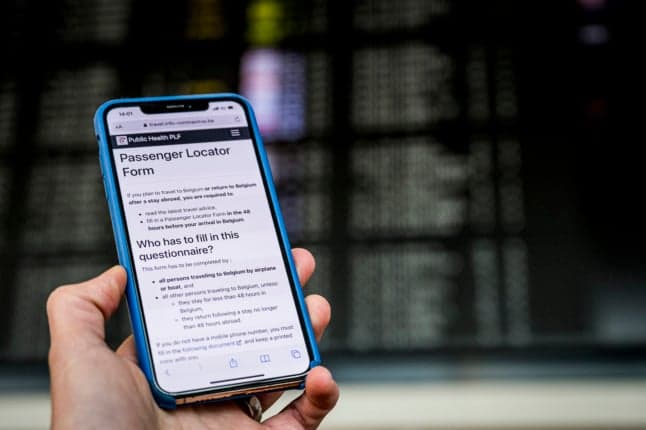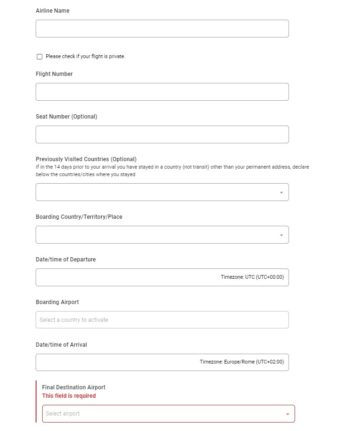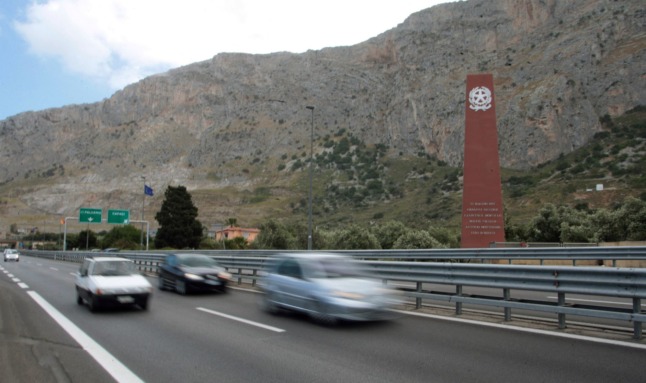How to use Italy's Covid passenger locator form for travel

Italy has an ongoing requirement to fill out a passenger locator form for travel this spring. Here's what you need to know.
**Please note that this article is no longer being updated. See all the latest travel news from Italy here.**
Italy has eased many of its pandemic-related travel restrictions since March, abolishing the restricted country of departure lists and ending the requirement for fully vaccinated and boosted passengers to take a test before travel.
However, that doesn't mean all entry restrictions have been dropped.
Q&A: Your questions about travel to Italy and Covid rules answered
One of the ongoing requirements is for all travellers to fill out a 'passenger locator form'. But this document continues to cause confusion for passengers, with readers of The Local getting in touch to ask when exactly they'll need it and how to fill it out.
Here's a quick look at what you need to know.
Q: Do I still need to fill out a Passenger Locator Form even though Italy relaxed its travel rules?
A: Although Italy's entry rules have been eased (see more details of Italy's current travel rules here) the requirement for all arrivals to complete a digital Passenger Locator Form (dPLF) is still in place.
In fact, the guidance says carriers have the right to refuse boarding to any passenger who fails to produce the form, while arriving at the Italian border without it could land you in quarantine for five days: so it's very important to make sure you have your completed dPLF with you when you arrive.
Q: Are there any exemptions?
A: The form "must be completed by all passengers arriving in Italy, by any means of transport", the Italian health ministry states.
This is a blanket rule that applies to all arrivals regardless of nationality, residency status, Covid vaccination status, or mode of transportation.
The latest health ministry travel ordinance does state that there is one exemption: for anyone travelling to a location in a foreign country that is less than 60km from their Italian place of residence for less than 48 hours does not require the form to re-enter Italy.
Those travelling a distance of less than 60km to Italy from their foreign place of residence for less than 48 hours are also not required to fill out a form - presumably to simplify things for people living in border towns.
Q: Where do I fill out the form and what information do I need to include?
A: The Italian health ministry instructs passengers to fill out the form online here.
You must then:
- select ‘Italy’ as the destination country
- register on the website by creating a personal account with username and password (required only the first time you use the website)
- confirm the account via the link sent to the email address provided (required only the first time you use the website)
- complete and send the PLF following the website instructions.
What information you'll need to include will depend partly on how you're travelling to Italy.
If you're flying, you'll be required to enter specific details of your flight on the form (see an example of the questions for airline passengers below).
You'll also need to enter your personal information including an ID or passport number, a permanent address, details of the address(es) you'll be staying at once you arrive in Italy, and contact details including a phone number.

Q: Do I need to print out the completed form?
A: You can show your completed form in either printed or digital format, according to the health ministry's instructions.
"Once the form has been sent, passengers will receive the PLF in PDF form and as a QR code at the email address entered during registration, which must be shown directly from a smartphone (in digital format) when boarding," the health ministry states.
"Alternatively, passengers can print a copy of the dPLF to show when boarding," it says.
"In exceptional cases, namely exclusively the lack of the required technology, passengers may complete a paper-based form."
Q: What if I'm travelling by train or car?
A: Italy requires all people entering the country to fill out a form, whether they're arriving by air, sea, or land.
Minors are included in this requirement; their form should be completed by the adult accompanying them, or if they are travelling alone, by their legal guardian.
For those travelling with a service provider, you simply need to provide the name of transportation company.
For passengers entering the country by private vehicle, the form is a little more involved. You will need to provide your car's registration plate and the name of the Italian border town through which you intend to enter the country.
A dropdown list of possible entry points is provided; if none of these look right to you, you have the option of selecting 'Other' and inputting a different name.
You're also required to enter your anticipated time of arrival into the form; obviously if you're travelling by car, you can only make a reasonable estimate.
Q: What if I'm just transiting through Italy?
A: Italy doesn't require passengers who are merely transiting through its airports to fill out a dPLF.
The EU Digital Passenger Locator Form websites states that passengers who remain within the Transit Area of the airport are NOT required to complete a dPLF. If for any reason one exits the airport, a dPLF will need to be completed.
However, if you decide to leave the airport for any length of time during your layover, you will need to fill out the form.
The website says: "All passengers wishing to enter Italy, via all means of transportation, will be required to complete the digital PLF prior to entering the country"; so it appears that if you intend to transit through Italy by car or train, a dPLF is required.
Q: If Italy is my final destination, do I still need to fill out a dPLF for any other countries I'm transiting through?
A: That depends on both the country and your means of transportation.
The EU Digital Passenger Locator Form website's FAQs section says "Travellers travelling by car need to submit a dPLF every time they enter a country that requires submission of dPLF."
However, the rules vary country by country: France, for example, says that only arrivals coming by plane need to fill out a form.

Q: How far in advance of my journey can/should I fill out my Italian passenger locator form?
A: The Italian health ministry's guidance says the dPLF should be completed "before entering national territory".
It says the form "can be completed at any time (weeks, days) before the trip, but must be sent before boarding and can always be amended until the time of boarding."
A completed form can be edited at any point before it is sent by logging in to your account and clicking the edit button.
Depending on the country, some parts of the form will locked and not editable. If you find that to be the case, you ought to be able to delete your form and start over.
For further details about Italy’s current Covid-19 health measures please see the Italian health ministry website or the foreign ministry website (both available in English).
Comments (2)
See Also
**Please note that this article is no longer being updated. See all the latest travel news from Italy here.**
Italy has eased many of its pandemic-related travel restrictions since March, abolishing the restricted country of departure lists and ending the requirement for fully vaccinated and boosted passengers to take a test before travel.
However, that doesn't mean all entry restrictions have been dropped.
Q&A: Your questions about travel to Italy and Covid rules answered
One of the ongoing requirements is for all travellers to fill out a 'passenger locator form'. But this document continues to cause confusion for passengers, with readers of The Local getting in touch to ask when exactly they'll need it and how to fill it out.
Here's a quick look at what you need to know.
Q: Do I still need to fill out a Passenger Locator Form even though Italy relaxed its travel rules?
A: Although Italy's entry rules have been eased (see more details of Italy's current travel rules here) the requirement for all arrivals to complete a digital Passenger Locator Form (dPLF) is still in place.
In fact, the guidance says carriers have the right to refuse boarding to any passenger who fails to produce the form, while arriving at the Italian border without it could land you in quarantine for five days: so it's very important to make sure you have your completed dPLF with you when you arrive.
Q: Are there any exemptions?
A: The form "must be completed by all passengers arriving in Italy, by any means of transport", the Italian health ministry states.
This is a blanket rule that applies to all arrivals regardless of nationality, residency status, Covid vaccination status, or mode of transportation.
The latest health ministry travel ordinance does state that there is one exemption: for anyone travelling to a location in a foreign country that is less than 60km from their Italian place of residence for less than 48 hours does not require the form to re-enter Italy.
Those travelling a distance of less than 60km to Italy from their foreign place of residence for less than 48 hours are also not required to fill out a form - presumably to simplify things for people living in border towns.
Q: Where do I fill out the form and what information do I need to include?
A: The Italian health ministry instructs passengers to fill out the form online here.
You must then:
- select ‘Italy’ as the destination country
- register on the website by creating a personal account with username and password (required only the first time you use the website)
- confirm the account via the link sent to the email address provided (required only the first time you use the website)
- complete and send the PLF following the website instructions.
What information you'll need to include will depend partly on how you're travelling to Italy.
If you're flying, you'll be required to enter specific details of your flight on the form (see an example of the questions for airline passengers below).
You'll also need to enter your personal information including an ID or passport number, a permanent address, details of the address(es) you'll be staying at once you arrive in Italy, and contact details including a phone number.

Q: Do I need to print out the completed form?
A: You can show your completed form in either printed or digital format, according to the health ministry's instructions.
"Once the form has been sent, passengers will receive the PLF in PDF form and as a QR code at the email address entered during registration, which must be shown directly from a smartphone (in digital format) when boarding," the health ministry states.
"Alternatively, passengers can print a copy of the dPLF to show when boarding," it says.
"In exceptional cases, namely exclusively the lack of the required technology, passengers may complete a paper-based form."
Q: What if I'm travelling by train or car?
A: Italy requires all people entering the country to fill out a form, whether they're arriving by air, sea, or land.
Minors are included in this requirement; their form should be completed by the adult accompanying them, or if they are travelling alone, by their legal guardian.
For those travelling with a service provider, you simply need to provide the name of transportation company.
For passengers entering the country by private vehicle, the form is a little more involved. You will need to provide your car's registration plate and the name of the Italian border town through which you intend to enter the country.
A dropdown list of possible entry points is provided; if none of these look right to you, you have the option of selecting 'Other' and inputting a different name.
You're also required to enter your anticipated time of arrival into the form; obviously if you're travelling by car, you can only make a reasonable estimate.
Q: What if I'm just transiting through Italy?
A: Italy doesn't require passengers who are merely transiting through its airports to fill out a dPLF.
The EU Digital Passenger Locator Form websites states that passengers who remain within the Transit Area of the airport are NOT required to complete a dPLF. If for any reason one exits the airport, a dPLF will need to be completed.
However, if you decide to leave the airport for any length of time during your layover, you will need to fill out the form.
The website says: "All passengers wishing to enter Italy, via all means of transportation, will be required to complete the digital PLF prior to entering the country"; so it appears that if you intend to transit through Italy by car or train, a dPLF is required.
Q: If Italy is my final destination, do I still need to fill out a dPLF for any other countries I'm transiting through?
A: That depends on both the country and your means of transportation.
The EU Digital Passenger Locator Form website's FAQs section says "Travellers travelling by car need to submit a dPLF every time they enter a country that requires submission of dPLF."
However, the rules vary country by country: France, for example, says that only arrivals coming by plane need to fill out a form.

Q: How far in advance of my journey can/should I fill out my Italian passenger locator form?
A: The Italian health ministry's guidance says the dPLF should be completed "before entering national territory".
It says the form "can be completed at any time (weeks, days) before the trip, but must be sent before boarding and can always be amended until the time of boarding."
A completed form can be edited at any point before it is sent by logging in to your account and clicking the edit button.
Depending on the country, some parts of the form will locked and not editable. If you find that to be the case, you ought to be able to delete your form and start over.
For further details about Italy’s current Covid-19 health measures please see the Italian health ministry website or the foreign ministry website (both available in English).
Join the conversation in our comments section below. Share your own views and experience and if you have a question or suggestion for our journalists then email us at [email protected].
Please keep comments civil, constructive and on topic – and make sure to read our terms of use before getting involved.
Please log in here to leave a comment.